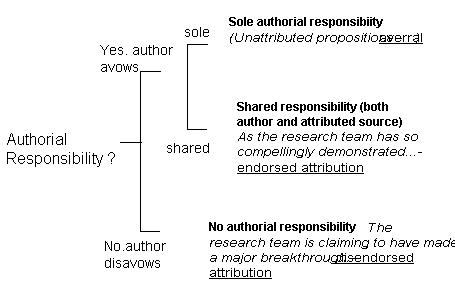


Return to Appraisal Homepage
4. Intertextual positioning 4
Responsibility
It may also be useful, in some analytical contexts, to consider these and related resources in terms of who is presented as taking responsibility for the utterance under consideration. Does, for example, the author,
- take sole responsibility for the utterance (as will typically be the case for all unattributed material),
- does the author present him/herself as taking NO responsibility for the utterance (as will typically be the case with dis-endorsed attributed material)
- or does the author indicate that he/she shares some responsibility for the utterance with the attributed sources (as typically the case with endorsed attributed material)?
Thus,

Figure 2: options for authorial responsibility
Source specification.
Another important issue relates to the nature of the source to whom the material is attributed. Here we are concerned with the nature and status of the social actor from whom/which the externally sourced statements are said to derived. Following closely the work on social actors by van Leeuwen ( 1996), we are interested in the following types of distinctions,
- (personalisation) Is the source represented as human (personalised) or as non-human (impersonalised, for example, a report, study or experiment)? If it is personalised, is it present as a particular human (or group of humans), or as an institutional sources - eg "The Prime Minister stated that... (human) versus "The Government is of the opinion that ...." (institutional)?
- (identification) Is the source named identified (named) versus unidentified (unnamed, anonymous or generalised) - for example, "The Minister, Mr Byers said..." (named) versus "A prominent backbencher said..." (unnamed); "The Australian Congress of Environmental Scientists believes..." (identified) versus "Environmental scientists believe..." (unnamed); or "informed sources indicate... (anonymous) or "it is generally believed that...", "there is a consensus that..." (generalised)?
- (specification) Is the source a specific individual or group, or an example of a generic class - eg "Staff at my son's school say they are unhappy with the new policy on class sizes" (specific) versus "Teachers say they are unhappy with the new policy on class sizes" (generic)?; "The members of my jazz band hold that Country and Western music ought to be outlawed" versus "Jazz musicians hold that Country and Western ought to be outlawed"; "40 percent of those interviewed for the survey believe that global warming is a real risk" (specific) versus "Australians believe that global warming is a real risk" (generic)
- (Grouping) Is the source an individual or a grouping - eg "My next door neighbour believes..." versus "My next door neighbours believe..." or "40 percent of Australians believe.." or "Cricket followers believe..."? or "Australians believe.."? If the source is a grouping, is it (a) an aggregate (groups of participants treated as a statistic) eg "40 percent of Australians believe..", "the people surveyed believe...", (b) a collective (people gathered together on the basis of some shared quality or feature), eg - "climate experts believe...", "Australians believe..." or (c) an association (a grouping contingently brought together essentially because they share the view which is being attributed at this point in he text) - eg "Both the Prime Minister and the Leader of the Opposition believe...", or 'politicians, bureaucrats and economists believe..."? (These associations will, of course, be made up of either individuals, or different types of groupings - thus "politicians, bureaucrats and economists" is an association of collectives.)
- (Status) Is the source associated with some level of status, authority or power in the current speech community? If so, would that status be high or low?
The type of sourcing employed by writer/speaker can be seen as having an impact on both the textual persona they construct for themselves and on the way they position their utterances with respect to likely responses from actual or potential respondents. Thus, following from what van Leeuwen (1996) has observed (and Bernstein 1970 and Bourdieu 1986 before him), to employ personalised, named individualised social actors as sources is to construct the speaker/writer as engaged concretely and directly with some specific-here-and-now, while to employ unnamed, generic and collectivised sources, for example, is to represent the author as in a position to distance him/herself from any specific reality, to generalise, abstract and universalise. Equally, of course, source type has an impact on dialogic positioning. Thus, by way of example, the writer/speaker may seek to suppress or challenge and disagreement by prospective respondents by the use of a high status or high authority source. The use of generic, large scale collectives may have a similar rhetorical functionality. These issues will be taken up in more detail in the next set of notes.




Return to Appraisal Homepage



